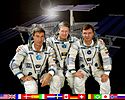Sojus TM-31
| Missionsemblem | |||
|---|---|---|---|
 | |||
| Missionsdaten | |||
| Mission: | Sojus TM-31 | ||
| NSSDCA ID: | 2000-070A | ||
| Raumfahrzeug: | Sojus 7K-ST (GRAU-Index 11F732) Seriennummer 205 | ||
| Trägerrakete: | Sojus U (GRAU-Index 11A511U) | ||
| Rufzeichen: | Уран („Uran“) | ||
| Besatzung: | 3 | ||
| Start: | 31. Oktober 2000, 07:52:47 UTC | ||
| Startplatz: | Baikonur 1/5 | ||
| Raumstation: | ISS | ||
| Ankopplung: | 2. November 2000, 09:21:03 UTC an das Modul Swesda | ||
| Abkopplung: | 6. Mai 2001, 02:21:09 UTC vom Modul Swesda | ||
| Landung: | 6. Mai 2001, 05:41:28 UTC | ||
| Landeplatz: | 90 km NO von Arkalik | ||
| Flugdauer: | 186d 21h 48min 41s | ||
| Erdumkreisungen: | 2927 | ||
| Umlaufzeit: | 88,6 min | ||
| Apogäum: | 249 km | ||
| Perigäum: | 190 km | ||
| Mannschaftsfoto | |||
 v.l. Krikaljow, Shepherd und Gidsenko | |||
| ◄ Vorher / nachher ► | |||
| |||
Sojus TM-31 ist die Missionsbezeichnung für den Flug eines russischen Sojus-Raumschiffs zur Internationalen Raumstation (ISS). Es war der erste Besuch eines Sojus-Raumschiffs bei der ISS und der 107. Flug im Sojusprogramm.
Besatzung
Startbesatzung
- Juri Pawlowitsch Gidsenko (2. Raumflug), Sojus-Kommandant (
 Russland)
Russland) - William Shepherd (4. Raumflug), Bordingenieur (
 Vereinigte Staaten)
Vereinigte Staaten) - Sergei Konstantinowitsch Krikaljow (5. Raumflug), Bordingenieur (
 Russland)
Russland)
Ersatzmannschaft
- Wladimir Nikolajewitsch Deschurow, Kommandant (
 Russland)
Russland) - Kenneth Duane Bowersox, Bordingenieur (
 Vereinigte Staaten)
Vereinigte Staaten) - Michail Wladislawowitsch Tjurin, Bordingenieur (
 Russland)
Russland)
Rückkehrbesatzung
- Talghat Mussabajew (3. Raumflug), Kommandant (
 Kasachstan)
Kasachstan) - Juri Michailowitsch Baturin (2. Raumflug), Bordingenieur (
 Russland)
Russland) - Dennis Tito (1. Raumflug), Weltraumtourist (
 Vereinigte Staaten)
Vereinigte Staaten)
Weitere Flugdaten
- Kopplung ISS: 2. November 2000, 09:21 UTC (an das Modul Swesda)
- Abkopplung ISS: 24. Februar 2001, 10:06 UTC (vom Modul Swesda)
- Kopplung ISS: 24. Februar 2001, 10:37 UTC (an das Modul Sarja)
- Abkopplung ISS: 18. April 2001, 12:40 UTC (vom Modul Sarja)
- Kopplung ISS: 18. April 2001, 13:01 UTC (an das Modul Swesda)
- Abkopplung ISS: 6. Mai 2001, 02:21 UTC (vom Modul Swesda)
Sonstiges
Der Zeitraum zwischen der Landung von STS-92 am 24. Oktober 2000 um 20:59:41 UTC und dem Start von Sojus TM-31 zur internationalen Raumstation ISS am 31. Oktober 2000 um 07:52:47 UTC war die bisher letzte Phase, in der sich kein einziger Mensch im All befand. Diese Phase dauerte sechs Tage und knapp elf Stunden.
Siehe auch
Weblinks
- Sojus TM-31 in der Encyclopedia Astronautica (englisch)
- Sojus TM-31 im NSSDCA Master Catalog (englisch)
- Sojus TM-31 bei space.kursknet.ru (englisch/russisch, archiviert 2016)
- Sojus TM-31 bei spacefacts.de
Auf dieser Seite verwendete Medien
Russian Soyuz TM-31 moves to Launch Pad, 29 October 2000.
The Soyuz TM-31 launch vehicle, which carried the first resident crew to the International Space Station, moves toward the launch pad at the Baikonur complex in Kazakhstan. The Russian Soyuz launch vehicle is an expendable spacecraft that evolved out of the original Class A (Sputnik).
Crew of ISS Expedition 1 launched with Soyuz TM-31
ISS Expedition One Commander William M. (Bill) Shepherd (center) is flanked by Soyuz Commander Yuri P. Gidzenko (right) and Flight Engineer Sergei K. Krikalev (left) in this crew photograph, taken during a break in training in Russia. The three, posed in front of a rendition of the International Space Station, are wearing the Sokol space suits like those they will don for their Soyuz-provided trip to ISS later this month. National flags representing all the international partners run along the bottom of the portrait.
Backdropped by a blanket of clouds, the Soyuz TMA-7 spacecraft departs from the International Space Station carrying astronaut William S. (Bill) McArthur Jr., Expedition 12 commander and NASA space station science officer; Russian Federal Space Agency cosmonaut Valery I. Tokarev, flight engineer; and Brazilian Space Agency astronaut Marcos C. Pontes. Undocking occurred at 2:48 p.m. (CDT) on April 8.










